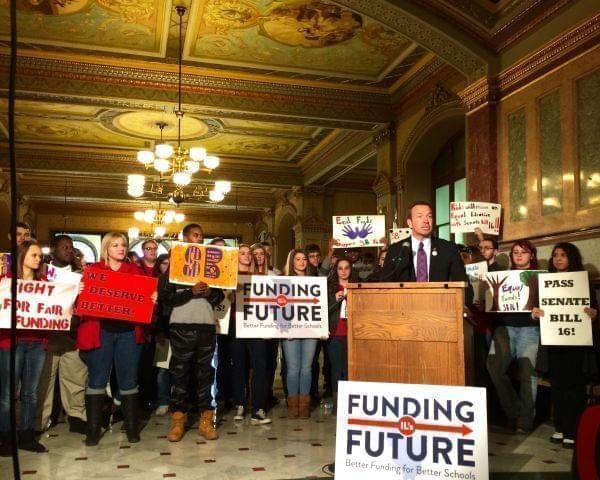School Funding Fight Set To Resume In Senate

State Sen. Andy Manar (D-Bunker Hill) speaks to supporters of his school funding bill at a rally in the Capitol rotunda in December. Dusty Rhodes/WUIS
When it comes to funding public schools, Illinois ranks near the bottom for equity. Legislation designed to change that stalled last session. Lawmakers are revising it to try again.
To understand the differences in school funding across Illinois, consider this partial list of art classes available at New Trier Township High School, in the Chicago suburb of Winnetka.
There’s ceramics, drawing and painting, glass art, photography, sculpture, video art, and even animation.
State Sen. Andy Manar (D-Bunker Hill) likes to list the art classes available downstate in Mulberry Grove, near Vandalia.
“There could be a child that enrolls in kindergarten in Mulberry Grove," he says, "And by the time that child gets to his or her senior year in high school, they will never have taken a single minute of an art course.”
Manar, a Democrat from Macoupin County, is the latest in a long line of lawmakers who want school funding overhauled (another major attempt in 1997 failed). He tells this Mulberry Grove story all the time, because it’s easy for people to digest.
Just try talking about the state’s current funding formula — actually three different formulas, plus federal aid, minus eleven percent...and you can see how people would lose interest.
Here’s the basics: In Illinois, schools are funded mostly with property taxes. That means that districts that encompass lots of prosperous businesses and expensive houses, like New Trier, spend more than $21,000 per student. Districts that have only residential property, farms, and maybe a few small stores get much less.
The state has set a magic minimum of $6,119 a school needs per student per year. If the district can’t generate that amount, the state is supposed to make up the difference. Even the wealthiest districts, like New Trier, get about $200 per student from the state.
In the last 4 years, though, the state has cheated on payments, ponying up only 89 percent of the pledged amount. The poorer the school district, the worse the pinch.
Manar’s bill would change this formula, taking some of the money that goes to prosperous districts and sending it to schools with more kids living in poverty. When he introduced it last session (as Senate Bill 16), suburban districts rallied against it. Rep. Ron Sandack (R-Downers Grove) sponsored a resolution to stop the bill.
“Those towns get very little state aid," he says, referring to suburbs in his district. “And so the little money they get, they’re going get cut is patently unfair.”
But downstate superintendents who had already cut their budgets weren’t swayed.
“In general do wealthy people want to give up their wealth or do they make it a habit of giving up their wealth? No. That’s how they become wealthy," says David Lett, superintendent of the Pana Community Unit School District. "But the reality is, this is beyond the issue of rich vs poor. It’s an issue of what’s right for children with a Pana zip code and a Taylorville zip code and a Mulberry Grove zip code.”
Lett is a spokesman for the Mid-Illinois Network of District Superintendents, or MINDS. None of the 16 school districts in MINDS have synthetic turf football fields, swimming pools, tennis courts, or many of the amenities found in suburban Chicago districts.
Gregg Fuerstenau, superintendent of Taylorville School District, also in MINDS, says his district's property tax base is limited.
“We’re predominantly residential and ag, or farm ground," he says.
With so little in property taxes coming in, Taylorville relies heavily on state aid. As the state reneged on the money schools were promised, Fuerstenau’s district was forced to close three of Taylorville’s six elementary schools.
Manar’s plan passed the Senate last session, even though it failed to get support from some downstate Republicans whose schools would’ve gotten more money. Among those: Senator Kyle McCarter, whose district includes Mulberry Grove. He wanted to tackle unfunded mandates – programs the state imposes on schools without providing additional funding.
McCarter came up with the idea of having local school districts pay teacher pensions, which are currently paid by the state for all schools except Chicago, in exchange.
“I proposed relief from unfunded mandates in trade for the pension burden coming down to local schools, which I’m the only one that’s come up with that,” McCarter says.
Manar says McCarter should put that in writing.
“Bring your ideas to the table in legislation," Manar says. "Not in platitudes, not in press releases, not in campaign gimmicks. But bring your legislation forward in the senate.”
Statehouse veterans who have seen similar efforts fail say school funding reform will pass when pigs fly. But Representative Sandack, who led the opposition last session, says this might be the right time for hogs to sprout wings.
“We’re at kind of these breaking points," McCarter says. "So it seems to me that with a Republican governor, and a Democratic dominated legislature, I actually think that’s a good potential opportunity for what I call a grand bargain on school reform on a macro level.”
Manar plans to file the new version of his bill, as Senate Bill 1, within the next two weeks.
UPDATE: McCarter says he has put his proposal in writing. It's called SB 72, proposing giving schools relief from unfunded mandates in exchange for downstate districts paying their own teacher pensions.
